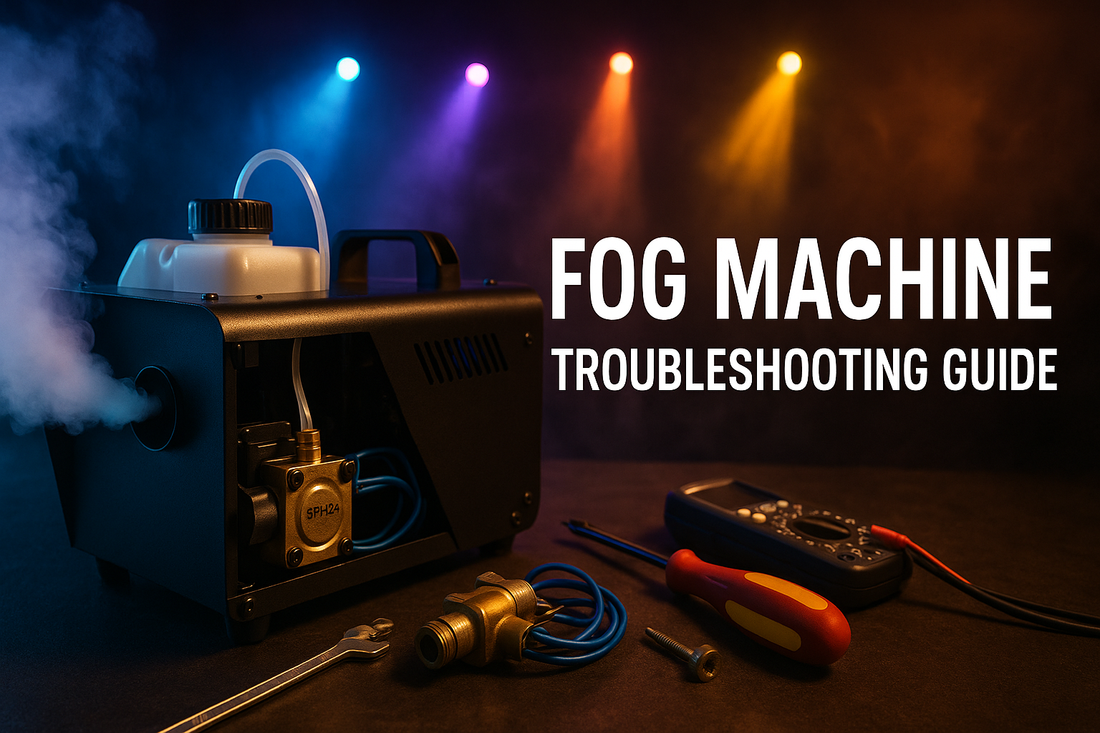
Why Your Fog Machine Suddenly Stopped Working (And How to Fix It in 30 Min)
yegongjiaoCompartir Why Your Fog Machine Suddenly Stopped Working (And How to Fix It in 30 Min)
No Fog? No Power? No Problem. Learn How to Troubleshoot and Replace a Failed Oil Pump Like a Pro.
You’ve set up the lights. The music is ready. Guests are on their way.
You press “test” on your fog machine —
Nothing happens.
No mist. No sound. Just silence.
Panic sets in.
But before you cancel everything or buy a new unit, take a breath.
Most fog machine failures aren’t terminal. In fact, the problem is often one small, replaceable part: the oil pump.
And if it uses a standard AC-powered piston pump like the SP-12A, there’s a good chance you can fix it — in under 30 minutes.
This guide will walk you through a real-world troubleshooting process used by technicians and event crews, so you can get your machine back online fast — without guesswork.

🔍 Step 1: Rule Out Power Issues
Before diving into internal components, start with the basics.
✅ Check:
Is the power cord fully plugged in?
Is the outlet working? (Test with another device)
Does the unit have a blown fuse? (Check near the power input)
Is the voltage correct?
⚠️ Important: The SP-12A oil pump operates on:
110–120V AC, 60Hz (standard in North America)
220–240V AC, 50Hz (standard in Europe, Asia, and many other regions)
Make sure your machine matches your local supply.
Some models automatically detect voltage; others require a manual switch. If mismatched, the pump won’t run — or could be damaged.
Also note: Some fog machines have thermal cut-off switches that disable operation if overheated. Let the unit cool for 15–30 minutes before retrying.
If the power indicator light doesn’t come on, the issue may be with the main circuit — but if the fan spins and heater glows… yet no fog comes out — keep reading.

🔧 Step 2: Diagnose the Core Components
A typical electric fog machine has four key parts:
| Component | Function |
|---|---|
| Power Supply | Delivers correct voltage to pump and controls |
| Fan & Motor | Blows air through the system |
| Oil Pump (e.g., SP-12A) | Draws fluid from tank using AC-powered piston mechanism |
| Heating Element / Nozzle | Heats liquid into vapor (fog) |
When the machine powers on but produces no fog, the fault usually lies in either the oil pump or the nozzle/heater.
Let’s test them one by one.
🛢️ Step 3: Is the Oil Pump Working?
The oil pump is responsible for moving fog fluid from the reservoir to the heating chamber. If it fails, no liquid reaches the heater — so no fog forms.
Here’s how to tell if your pump is faulty:
🔊 1. Listen for the Hum
Turn the machine on.
Put your ear close to the fluid tank area.
You should hear a distinct low-frequency “hum” or “clicking” sound — this is the AC-driven piston pump cycling.
❌ No sound? The pump may be:
Electrically disconnected
Burned out (coil failure)
Mechanically seized (due to dried seals or debris)
🔥 2. Feel for Vibration (Not Heat)
Unlike DC motors, AC pumps like the SP-12A generate noticeable mechanical vibration, not just heat.
✅ Normal: Steady pulsation felt when touching the pump housing
❌ Warning sign: No vibration, even though power is applied → likely electrical or mechanical failure
⚠️ Do not touch exposed wires or terminals. Always unplug before inspection.
👀 3. Watch the Oil Line (If Visible)
Some machines have transparent tubing between tank and nozzle.
When activated, you should see pulsing movement of fluid.
❌ No flow? Either:
The pump isn’t receiving power
The intake filter is clogged
The tank is empty or improperly seated
💡 Pro Tip: Disconnect the output tube and place the intake end in clean water. Activate the machine. If it doesn’t draw water, the pump is likely faulty.

🔧 Step 4: Replace the Oil Pump (In Under 30 Minutes)
If diagnostics point to a failed pump, replacement is often faster and cheaper than repair — especially if your model uses a standardized AC piston pump like the SP-12A.
These pumps are designed for durability and field serviceability in professional fog machines.
✅ What You’ll Need:
Phillips screwdriver
Replacement SP-12A type AC oil pump (confirm voltage compatibility)
Clean cloth
Optional: Multimeter (to verify AC input)
🛠️ Step-by-Step Replacement Guide:
1. Unplug and Cool Down
Always disconnect from wall power and let the unit sit for 5–10 minutes.
2. Drain Remaining Fluid
Empty the tank completely to avoid spills during disassembly.
3. Remove Outer Casing
Use a screwdriver to remove screws (usually T10 or Phillips). Set aside carefully.
4. Locate the Pump
It’s typically mounted near the fluid tank, connected by two AC power wires and one or two silicone tubes.
📌 Note: Take a photo before disconnecting for reassembly reference.
5. Disconnect Wires and Tubing
Carefully detach the two main power wires (often spade connectors or quick-disconnect terminals).
Loosen hose clamps and slide tubes off the pump nozzles.
⚠️ Never force connections. Label wires if needed.
6. Install the New SP-12A Pump
Position the new pump in the same orientation.
Reconnect the two AC power wires (polarity does not matter for AC).
Slide tubes back onto outlets and secure with clamps.
Ensure all seals and gaskets are properly seated.
✅ Advantage of SP-12A-style pumps: They are drop-in replacements with standardized mounting dimensions and connections, widely used across commercial and semi-professional fog machines.
7. Reassemble and Test
Reattach casing.
Refill with compatible fog fluid.
Plug in and activate.
You should hear the familiar hum return — and within seconds, see fog output.
⏱️ Total time: 15–30 minutes, depending on experience.
🛡️ How to Avoid Future Failures
Even robust AC pumps like the SP-12A can fail prematurely if misused. Follow these best practices:
✅ Use Proper Fog Fluid
Never use homemade mixtures (water + glycerin, etc.) unless specified.
Impurities cause buildup and corrosion.
Use only manufacturer-recommended or high-purity fog oils.
✅ Don’t Run Dry
Always ensure fluid level is adequate.
Running the pump without liquid causes rapid wear on piston seals.
✅ Clean Periodically
Flush the system every 20–30 hours of use.
Some users run distilled water through the pump after events to clear residue.
✅ Store Properly
Keep in a dry, room-temperature environment.
Empty the tank if storing long-term to prevent seal degradation.
🎯 Why Choose a Standardized AC Pump Like SP-12A?
Not all pumps are created equal. The SP-12A and compatible models offer several advantages for reliable performance:
| Feature | Benefit |
|---|---|
| AC Operation (110–120V / 220–240V) | Direct mains connection, no external power supply needed |
| Dual Voltage Compatibility | Works globally with proper wiring or adapter |
| Robust Piston Design | Handles continuous duty cycles better than diaphragm pumps |
| Modular Wiring Terminals | Easy field replacement without soldering |
| Durable Seals | Resists wear from long-term use with proper fluids |
These pumps are commonly found in:
Professional stage foggers
Theater and film effects systems
Permanent installation venues
High-output mobile DJ setups
🔍 Important: Always verify that your replacement pump matches both voltage and physical dimensions. While "SP-12A" refers to a common form factor and specification, confirm flow rate, pressure, and mounting style before purchase.

✅ Final Thoughts
A broken fog machine doesn’t mean game over.
In most cases, the culprit is a failed oil pump — a small component that’s easy to diagnose and even easier to replace.
By following this guide, you can troubleshoot confidently and restore functionality in under half an hour.
And next time?
Keep a spare SP-12A AC oil pump in your kit — matched to your region’s voltage.
It might just save your show.
🔧 Need a Replacement Pump?
👉 Browse Compatible AC Oil Pumps (SP-12A Type)
📦 Ships Worldwide | ✅ 1-Year Warranty | 📞 Technical Support Available
✅ Disclaimer:
This guide provides general troubleshooting advice for common fog machine issues. Always follow manufacturer instructions and safety guidelines when servicing electrical equipment. We are not affiliated with any specific fog machine brand. SP-12A refers to a widely used AC-powered piston pump model; availability and specifications may vary by supplier. Confirm voltage and compatibility before installation.


